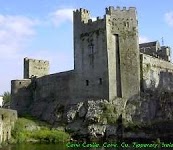The Moat Of Knockgraffon
Knockgraffon means the Hill of the fort of Fionn. The Moat is pre-christian and one of the finest Moats in Ireland. Situated three miles from Cahir it is said to be the coronation place for the high Kings of Munster and as many as seventeen kings are buried beneath it. The short steep climb to the top rewards the energetic climber with a panoramic view of Tipperary’s Golden Vale, Galtees, Slieve Na mBan, and the Commeraghs. It is noted for it’s fairy stories and a place where ceol sidhe, the music of enchantment could be heard.
Golden Castle
Situated on the river Suir, Golden is a popular angling spot. The remains of a Tower House on the bridge dominates the village. In 1690 William 111 is reputed to have written a letter from this bridge to the Corporation of Cashel renewing the Charter granted to it by Charles 1.

Athassel Abbey
Close by to Golden are the ruins of Athassel Abbey, once the largest medieval priory in Ireland. The building of the Abbey was part of king Henry 11’s plan to rule Ireland with the “cloth and kindness” rather than the sword. This can be reached by a leisurely walk along the banks of the river Suir. A riverside park offers the visitor an ideal opportunity to picnic, fish or just enjoy the peaceful surroundings.

Thomastown Castle
The village of Thomastown is recognisable by the statue of Fr. Theobald Mathew founder of the Temperance movement in the country. From the village one can see the remains of the once magnificent Thomastown Castle the home of the Mathew family. Dean Swift enjoyed many a visit to the castle at the height of its grandeur.

Cahir Castle
Once the stronghold of the powerful Butler family, the castle retains its impressive keep, tower and much of its original defensive structure.
When you get there and look closer you immediately see, that castle has been built in the island and on the natural limestone rock. Before the Butler family took it over, there was a earthen stronghold belonging to local chief.
The Butler family owned this castle for 700 years and as they were great diplomats, it was one reason the castle was never fully destroyed during wars.
It has attracted film-makers such as John Boorman who shot scenes for the film “Excalibur”. Also shot here were scenes for “Tristan and Isolde” movie starring Richard Burton. More recently the Castle was filmed for the production of “The Tudors”.
In the Square can be seen a statue of the Blind Piper, Edward Keating who composed the famous “Foxchase” music for the Uileann Pipes and played for King George 1V when he visited Ireland in 1821. Nearby is a plaque on the wall for Crimean Bob a veteran troop horse which died in the Barracks in Cahir.

Swiss Cottage, Cahir
A delightful cottage orné built in the early 1800s by Richard Butler, 1st Earl of Glengall to a design by the famous Regency architect John Nash. Its interior contains a graceful spiral staircase and some elegantly decorated rooms. The wallpaper in the Salon manufactured by the Dufour factory is one of the first commercially produced Parisian wallpapers. Situated on an elevated site with access by stone steps. Please note that this is a very busy site and visitors may experience a delay during the Summer month.

Lena Rice Garden, New Inn
Situated on the Clonmel road out of New Inn is the garden to commemorate the memory of Lena Rice who was the only Irish Lady to become a Wimbledon champion. She was the only Irish woman to have won the coveted title. Her achievements in 1890 were remarkable in that her lawn tennis career spanned just two seasons and no more than a handful of tournaments.
Lena never married and died on her 41st birthday, the same age as her father, on June 21st 1907. She was buried in the Protestant Cemetery at Downey’s field with her brother Samuel who died age three. Her grave which was neglected was re-discovered in 1984 in a village clean-up.

